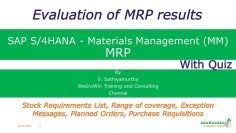This video tutorial delves into the concept of Free Goods in SAP S/4HANA Sales and Distribution (SD). The speaker provides a comprehensive explanation of the topic, with practical demonstrations in the SAP system. Here are the key points:
- Overview of Free Goods: Free goods are additional products given to customers at no extra charge. This is a common practice in many businesses. The free product can be the same as or different from the product being sold.
- Manual Free Goods Entry: The speaker demonstrates how to manually enter free goods in a sales order. This involves adding an item to the order and changing its item category to TAAN, which designates it as a free item.
- Automating Free Goods Entry: To automate the entry of free goods, you need to set up Free Goods Master Data. This allows the system to automatically add free goods to an order based on predefined rules.
- Inclusive and Exclusive Free Goods: The speaker explains the difference between inclusive and exclusive free goods. Inclusive free goods are the same product as the one being sold and are included in the order quantity. Exclusive free goods can be a different product and are added to the order quantity.
- Calculation Rules: The speaker discusses three calculation rules for free goods: prorata, unit reference, and whole unit. These rules determine how the system calculates the quantity of free goods based on the order quantity.
- Creating Free Goods Master Data: The speaker demonstrates how to create Free Goods Master Data using transaction code VBN1. This involves specifying the sales organization, distribution channel, customer code, validity period, minimum quantity, calculation rule, and free goods.
- Testing Free Goods in a Sales Order: The speaker creates a sales order to test the Free Goods Master Data. The system automatically adds free goods to the order based on the rules defined in the master data.
- Fiori Application for Free Goods: The speaker shows how to use the Fiori application to maintain Free Goods Master Data. This application provides an HTML version of the GUI screen for maintaining free goods.
- Customizing Calculation Rules: The speaker explains that you can customize calculation rules based on business requirements. This involves creating routines, which are pieces of ABAP coding.



























